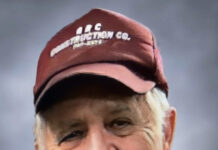Welcome to Burrillville Then & Now, a feature on NRI NOW.
With photos provided by the Burrillville Historic & Preservation Society, we take a glance back at how the town used to look, then show how the same space looks today. Betty Mencucci, president of BH & PS has provided historical information on the site.
Today, we look at the history of the Bridgeton School.

The area around Serio’s Pizza and the White Mill Park used to be called Bridgeton. It was a village with a post office, a schoolhouse, stores and a mill. When the Bridgeton post office closed, Bridgeton became part of Pascoag.
By early 1897 the old Bridgeton school building, which was located on East Wallum Lake Road, was condemned by the State Commissioner of Public Schools as unfit for educational purposes. In May of 1897 plans for a new school were presented by architect George W. Spaulding of Woonsocket.

Read more about the above advertised project here.
The plans were accepted and it was decided that the new school was to be built on the Bridgeton end of Sayles Avenue. In June, there was a big controversy over the proposed site; other sites were chosen and a special meeting was held to select a site. Nehemiah Kimball’s lot was chosen and he was awarded the contract to build the school at a cost of $3,250 plus $750 to purchase the lot.
By August 6, the foundation was complete. William H. Gory was hired to do the framing and by September 3, the framing was completed to the second floor. By October 1, the school was plastered and they were ready to start the interior woodworking. By November 19, the desks and seats were installed as well as a heating system.
On November 29, 1897 the Bridgeton Primary School was dedicated. It was a primary school for children in grades 1-4. However, when it opened, only one room was used. The new school teacher was Bertha N. Smith making $42 per week with 76 students enrolled, but only an average number of 39 attending. The next year, Smith resigned and Abbie G. Riley became the teacher.

Beginning in 1900 the school had two teachers with both classrooms being used. One teacher taught two grades in the same room. Classes for grades 1 and 2 were held in the room on the left and classes for grades 3 and 4 on the right.
In 1914 one side of the roof was leaking causing damage inside the building. Large pieces of the plaster ceiling fell and considered a hazard to the students. To eliminate this hazard, tin ceilings and a new roof were installed.
Most of the students were from Bridgeton. The school also took in the overflow from nearby Pascoag, as far away as the junction of Broad Street and High Street, about a mile away. The enrollment at the Bridgeton School steadily increased and in 1935, the school had its largest enrollment with 101 pupils: 52 in grades 3 and 4, and 49 in grades 1 and 2.
In 1928 inside toilets were installed in the basement. Before this, there had been separate outhouses for girls and boys in the rear of the school building.

On the last day of school in June 1966, the Bridgeton School closed its doors. In 1970 it re-opened as a kindergarten and was called the Joseph C. Sweeney School and painted red. Mr. Sweeney had served the town of Burrillville as principal of the high school from 1905 to 1910, and as superintendent of schools from 1910 to 1949.

The Sweeney School closed in 1995 when the Steere Farm Elementary School opened.
In 1996 the Burrillville Historical & Preservation Society purchased the building from the town for $1, and uses it as the headquarters for the Society. In October 2000 a formal ceremony was held dedicating the meeting room on the right side as the Joseph C. Sweeney Room and the research room on the left side as the Marilyn Johnson Room. Marilyn Johnson was a charter member of the Burrillville Historical & Preservation Society and a teacher at the school for many years. Monthly meetings are held with accompanying educational/historical programs and permanent and changing exhibits. The Bridgeton School is important to the town in that it serves as a repository for all items pertaining to Burrillville history including old photos, newspaper clippings, artifacts, genealogical research material and written histories.
Complete restoration of the bell tower occurred in 2004 and a 13” bronze bell was hung on a newly constructed bell frame and yoke. The entire mechanism is attached to the original wood timbers of 1897. It is not the original bell. This bell was donated by a former superintendent of schools and is said to have come from a schoolhouse in Mapleville.

In 2005 complete restoration of the exterior was completed and a paint analysis was conducted to determine what color the building should be painted. It was discovered that the original colors of the building were a shade of yellow called “spring dust” with dark green trim, and so the Bridgeton School was painted with these colors.
The Burrillville Historical & Preservation Society is always looking for old photos to add to its collection. If you do not wish to donate your photos, we can scan them and give back your originals. We are very interested in any photos for any time period of the Bridgeton School/Sweeney School. Please contact Betty at 568-8449 or [email protected].







